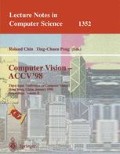Abstract
In this paper we present an algorithm for analysis of the range data of cloth drapes. The goal of the analysis is estimation of parameters for modeling and the geometry of the underlying object. In an analysis-by-synthesis manner, the algorithm compares the drape of the model with the range data and searches for the best fit. It can be applied to any physics-based cloth model. The motivating application is fashion design using CAD systems, but the ability of the algorithm to estimate the shape of the object supporting the scanned cloth indicates the possibility of utilizing cloth models to overcome problems in human tracking algorithms, caused by clothing.
Preview
Unable to display preview. Download preview PDF.
References
G. Borgefors. Distance transformations in arbitrary dimensions. Computer Vision, Graphics, and Image Processing, 27:321–345, 1984.
D. E. Breen, D. H. House, and M. J. Wozny. Predicting the drape of woven cloth using interacting particles. In Proceedings of SIGGRAPH '94, pages 365–372, 1994.
M. Carignan, Y. Yang, N. Magnenat Thalmann, and D. Thalmann. Dressing animated synthetic actors with complex deformable clothes. In Proceedings of SIGGRAPH '92, pages 99–104, 1992.
J. R. Collier, B. J. Collier, G. O'Toole, and S. M. Sargand. Drape prediction by means of finite element analysis. Journal of the Textile Institute, 82(1):96–107, 1991.
N. Jojic and T. S. Huang. 3d reconstruction of multipart, self-occluding objects. In these proceedings (ACCV '98).
H.N. Ng, R. L. Grimsdale, and W. G. Allen. A system for modeling and visualization of cloth material. Computer Graphics, 19(3):423–430, 1995.
W. H. Press, S. A. Teukolsky, W. T. Vetterling, and B. P. Flannery. Numerical Recipes in C: The Art of Scientific Computation. Cambridge University Press, 1995.
D. Terzopoulos, J. Platt, A. Barr, and K. Fleischer. Elastically deformable models. In Proceedings of SIGGRAPH '87, pages 205–214, 1987.
Author information
Authors and Affiliations
Editor information
Rights and permissions
Copyright information
© 1997 Springer-Verlag Berlin Heidelberg
About this paper
Cite this paper
Jojic, N., Huang, T.S. (1997). On analysis of cloth drape range data. In: Chin, R., Pong, TC. (eds) Computer Vision — ACCV'98. ACCV 1998. Lecture Notes in Computer Science, vol 1352. Springer, Berlin, Heidelberg. https://doi.org/10.1007/3-540-63931-4_250
Download citation
DOI: https://doi.org/10.1007/3-540-63931-4_250
Published:
Publisher Name: Springer, Berlin, Heidelberg
Print ISBN: 978-3-540-63931-2
Online ISBN: 978-3-540-69670-4
eBook Packages: Springer Book Archive

